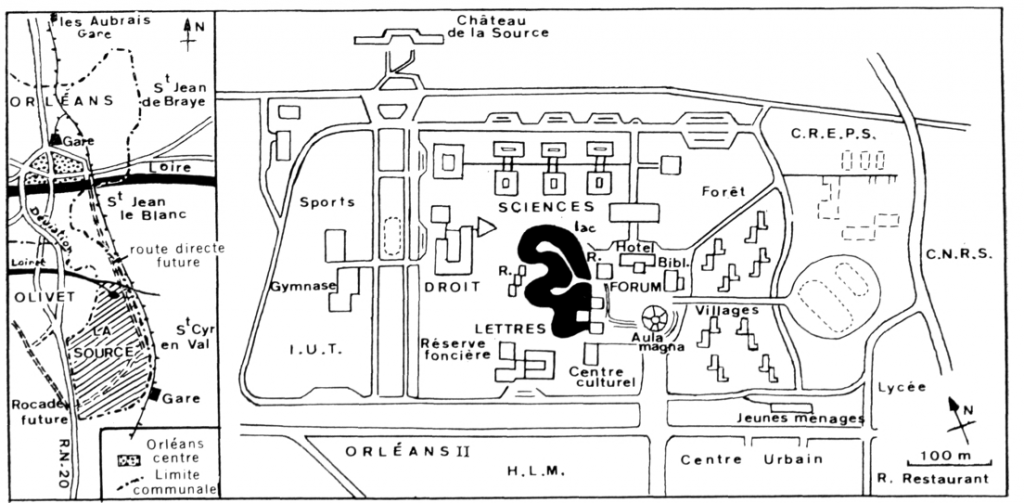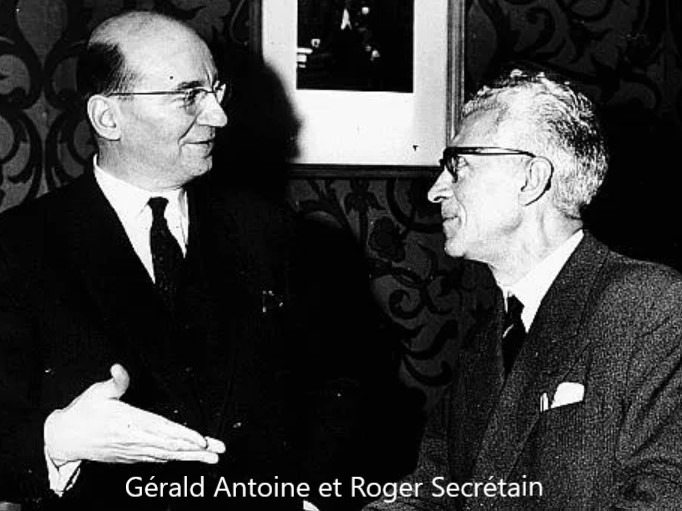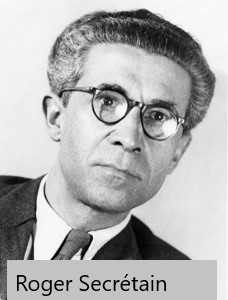The path that led to choosing this land in La Source as the seat of the current university was not made in one piece and is closely linked to the context of the time. The beginning of the 1960s was indeed marked by a densification in higher education. Faced with the growing number of students, which remains mainly concentrated in Parisian universities, a decentralization movement begins. It will favor cities close to the capital, such as Orleans.
To this movement of Parisian decentralization adds the will of the municipality of Orleans (and in particular of its mayor Roger Secrétain, elected on March 20, 1959) to revitalize the city. In this search for dynamism, reviving the University of Orleans, considered one of the oldest in Europe, appears to be a key point.
The day after Roger Secrétain’s election, the possibility of setting up a University Scientific College in Orleans was discussed. This prospect is remarked at the highest summit of the State : in a letter dated September 10, 1959, Prime Minister Michel Debré thus declared “I want to tell you that I am still closely following the problem of Parisian decentralization and that Orleans cannot be forgotten ! “.
At the same time, the city of Orleans was facing a housing crisis due to an ever growing population. As a matter of fact, the municipality also had to welcome, at the request of the State, repatriates from Algeria. This housing crisis then had an impact on the university project : the lack of available intramural space was making it impossible to build in Orleans itself. This choice would have led to the destruction of buildings which had just been rebuilt after the Second World War, and Mayor Roger Secrétain refused.
These two factors, combined with that of the fall in the price of land, led the municipality and the Departmental Council of Loiret to jointly acquire in 1959 the Domaine de la Source as well as its castle. At the time, the estate was attached to the town of Saint-Cyr en Val.
Unlike the urban area of Orleans which was fully rebuilt after the Second World War, the Domaine de la Source is “a rural and wooded area where the Loiret, an affluent of the Loire river, takes its source at a place called “Le Bouillon”” (which is a reference to water bubbling, as if it was boiling). What would later take the name of La Source district was just a wooded area devoid of any buildings except the La Source Castle.

© archives of Orléans Métropole
In parallel with this acquisition, an university expansion committee met in March 1959. This newly created committee was initially responsible to think about the location of the future campus. Among the lands considered was the property of Saint-Loup in Saint-de-Braye, but also the La Source Castel itself. After several months of reflection, and given the number of students, it is the latter which was chosen as the location of the future university center.
The project of Orléans II
An ambitious project emerged : “Orléans II”, led by Roger Secrétain, in collaboration with rector of the Orléans-Tours academy Gérald Antoine. This project, carried out from 1963 to 1978, included the construction of the new town and that of the university. In 1962, Pierre Sudreau, then Minister of National Education, entrusted the architects Louis Arretche and Olivier-Clément Cacoub. The two architects worked together by harmonizing their plans.
What was then called “Orleans II” will take its final name in 1964; Orléans-la-Source with the attachment of the district to the city of Orleans, is characterized by its off-center position in relation to North Orléans. Its eccentric position and the concomitant creation of the new city of La Source will induce the project leaders to build an autonomous campus like the North American ones. Very quickly, the university project was evoked in the newspapers as a “French Oxford”, a name attributed to Pierre Sudreau, which was notably declined in the press as “Oxford-upon-Loire”.
Since the Domaine de la Source was devoid of any development in the early 1960s outside of the La Source Castle, the University Scientific College moved first to the castle and then to prefabricated buildings. A sign of the collaboration and involvement of the mayor of Orléans Roger Secrétain and the rector Gérald Antoine, the municipality participated in the financing of the provisional installations on the grounds of the castle while awaiting the financing, by the State, of the final installations.

A will to include the campus in the city
Following the design of the American-style campus, the La Source Development Project considered the city and the university campus in an inclusive manner. Beyond its teaching role, the university was originally thought of as a place of life, of meeting welcoming both students and inhabitants of the city of La Source.
This is particularly noticeable in the initial project as it emerges from the ground plan; in addition to the facilities provided for the various lessons, the creation of a forum was planned, revolving around an artificial lake, designed by Olivier-Clément Cacoub. Within it, a student house project was envisaged, open to both students and the population of La Source. This Student House was to include an “experimental theater, a radio-television studio, a photo-cinema club, an exhibition space, music and dance halls”. This project will ultimately remain a dead letter.

Everything in the initial project was designed to make the university campus a meeting place, integrated into La Source district, which is illustrated by the absence of a fence as well as the alleys open for residents around the lake. To the north of the Domaine de la Source, adjoining the floral park, designed in 1963 by Louis Arretche, is the university campus, a high school and the C.N.R.S which sets up some of its laboratories at the Source. In fact, the joint desire of Roger Secrétain and Gérald Antoine was also to make Orléans-la-Source a city focused on research. Thus, in addition to the C.N.R.S installs the B.R.G.M. Further south, directly adjacent to the university campus, is the urban center: “it is the new town of Orleans II which will provide the university and the C.N.R.S with a modern and complete urban setting”.
However, once more, the connection between the campus and the city never came to fruition. First of all, in its very conception, the urban part was not able to create this link with the university. More concretely, in Orléans-la-source, the housing policy of the time favored large housing estates, although at the time it was a symbol of modernity occupied by rather upper social classes, thus likely to produce students for the university campus. In the 1970s, the level of comfort slipping and rising in range, the population deserted these large complexes and their sound insulation problems, for single-family houses. In the end, despite the original will of its designers, no real link was ever created between the university campus and the La Source district.


